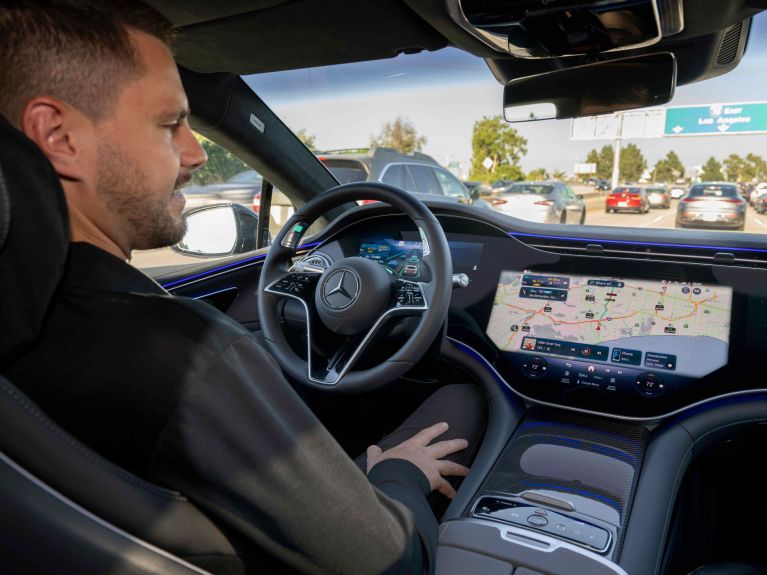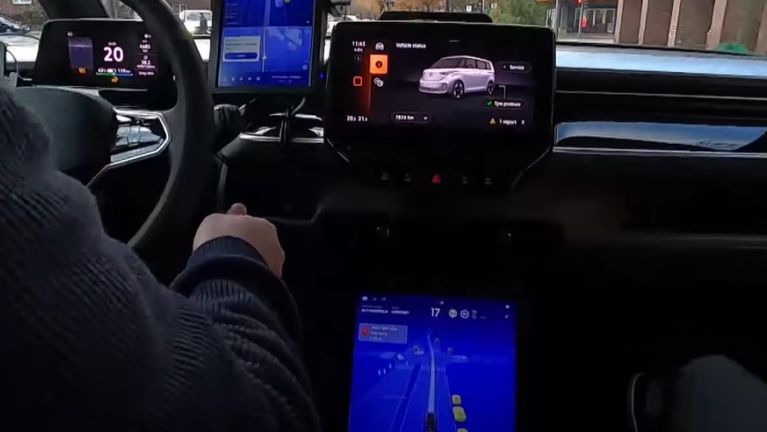The future of mobility: driverless vehicles
Be it in logistics, agriculture or on the roads: highly automated vehicles are becoming increasingly important. Germany is playing a key role in this.

Once the domain of science fiction, it’s now gradually becoming reality: driverless vehicles cruising through the streets, steered as if by an invisible hand. Nowadays, it’s not just logistics vehicles on industrial premises, agricultural machines on fields or shuttle services on specially designated routes that can drive themselves - increasingly, buses, robotaxis, lorries and private cars on the roads can too. The Society of Automotive Engineers (SAE) defines five stages of automation. Many modern vehicles already feature level 1 and level 2 assistance systems - though they take care of some of the driving activities, the driver still has to be ready to intervene at any time. These include systems that keep the vehicle at an appropriate distance and in the right lane, apply the brakes to avoid a collision or park the vehicle. Level 3 means that the vehicle can drive itself, though the human at the wheel still has to be ready to take over if necessary. A level 4 vehicle is highly automated and can drive itself in defined areas without human support.A And level 5 vehicles are fully autonomous.

Germany is a trailblazer
In 2021, Germany was the first country in the world to establish a legal framework that will allow highly automated vehicles to be operated in public spaces - under certain conditions even at speeds of up to 130 kilometres per hour on the autobahn. Advocates of the technology argue that autonomous vehicles could reduce the number of road accidents, most of which are the result of human error. They also talk about the gains in terms of efficiency and comfort because drivers could spend their time doing other things. Furthermore, autonomous vehicles would reduce the need for qualified personnel on local public transport networks. And they would open up new mobility options for people with physical disabilities. The technology would also have environmental benefits, as driverless vehicles are usually emission-free and reduce congestion thanks to their optimised driving style.
High levels of complexity
There are challenges, however: the level of technical complexity required is very high given that driverless vehicles have to assess road traffic situations quickly and reliably. Then there are legal issues, such as the question of liability when accidents do occur. And last but not least, many people are still sceptical about vehicles that look as if they are being driven by a ghost.
One thing is certain, however: the German automotive industry is actively advancing this future technology. For example, Mercedes-Benz has developed the “Drive Pilot”, the world’s first level 3 system to be approved for use on the autobahn at speeds of up to 95 kilometres per hour. The Drive Pilot uses over 35 sensors, including cameras, radar, ultrasonic sensors and LiDAR (laser radar) to monitor its surroundings in real time. The redundant system ensures that critical vehicle functions such as steering, braking and electronics are duplicated to ensure safety. The famous carmaker with the star logo is also working hard on level 4 and is already trialling vehicles on roads and motorways in Beijing.

Driverless vehicles on the roads: numerous pilot projects
Numerous pilot projects are underway in Germany to advance the technology. The focus is on self-driving shuttles designed to complement existing local public transport services. Volkswagen for instance is currently testing self-driving minibuses with a view to introducing them on the streets of Hamburg from 2026. “We are bringing driverless vehicles to Europe, to Germany, to Hamburg. This is an important step towards the future of local public transport,” says Hamburg’s Transport Senator Anjes Tjarks.
With the support of automotive supplier ZF, fully automated buses are being trialled on urban and rural roads in Mannheim and Friedrichshafen. Berlin is also testing self-driving delivery vehicles and on-demand shuttles designed to reduce congestion. These projects are all helping to gather real-world experience, increase acceptance and integrate the technology into our daily lives, step by step.
Dieses YouTube-Video kann in einem neuen Tab abgespielt werden
YouTube öffnenThird party content
We use YouTube to embed content that may collect data about your activity. Please review the details and accept the service to see this content.
Open consent form
Considerable potential for goods transport
Driverless vehicles also offer considerable potential when it comes to transporting goods. In cooperation with the US firm Aurora, Continental is for example developing a scalable level 4 system for lorries that it hopes will go into series production in 2027. “Thanks to our driverless transport solutions, we are boosting efficiency, maximising vehicle utilisation and reducing downtime,” says Ismail Dagli, head of Autonomous Mobility at Continental. While Aurora is supplying the software and AI algorithms, Continental is contributing its expertise in sensors, security architectures and vehicle integration. A fallback system is provided to ensure continued vehicle operation in the event of a technical fault.



